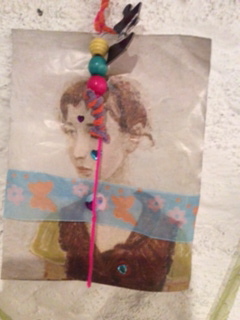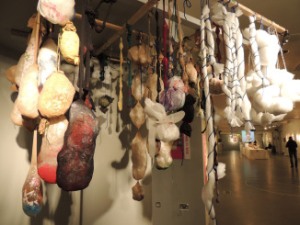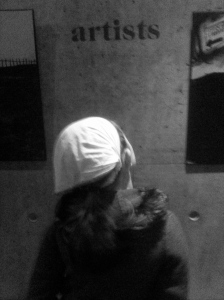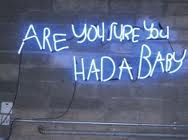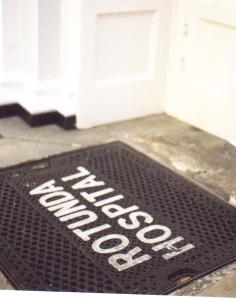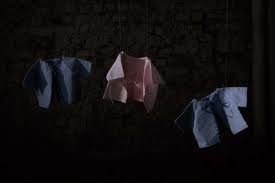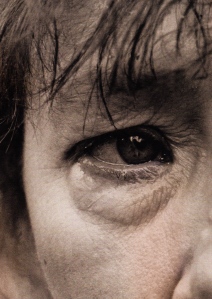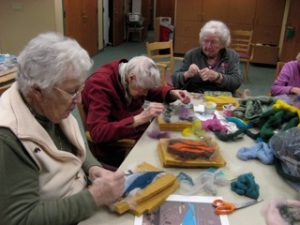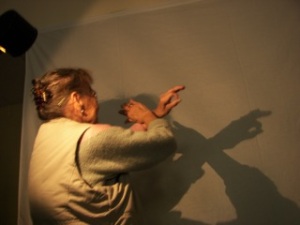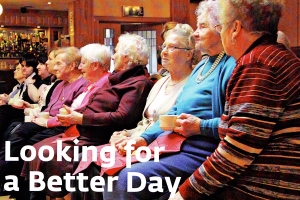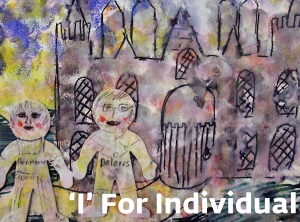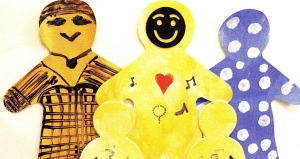Art Out Loud: What Art Means to Children
February 17, 2014
Supported by Create Louth and The Basement Gallery, Dundalk
Art Out Loud is an expressive space for children to talk about their lives surrounded by artworks from the County Louth Art Collection (Taisce Lú). As a context for both discovery and reflection, the Basement Gallery offers a supportive structure for considering ideas that impact children’s analysis of both themselves and others. Here the stories of artists connect with the stories of children. As a result children examine their own perspectives, in relation to what they learn about the role of contemporary art as a channel for communication.
An art gallery offers the potential of new knowledge, the possibility of reflecting upon identity and well being. It is a place to find one’s bearings, to gather thoughts and to make sense of one’s place in the world at large. Art offers a springboard for communication; it is a way to connect with others, to discuss points of view, and to disagree. Children aged 10-12 have described contemporary art as a way of making something out of nothing, of building ideas with materials, and learning about life in different ways.
In conjunction with the exhibition, participating children are developing an installation composed of personal items that reflect their lives (i.e. toys, games, books, DVD’s, trinkets, etc.). The theme of this ongoing installation is “making a space a place”, and highlights the use of found objects and readymades in contemporary art. The children are donating their own collections of personal paraphernalia, discussing how their lives can also be a form of art in the making.
Teachers have noted that pupils have responded to the art exhibition in ways that far exceeded their expectations, including producing fascinating artworks from personally significant everyday materials.
For more information about the project, contact Pamela Whitaker info@groundswell.ie
Articulate: The Art Gallery as Therapeutic Space
December 20, 2013
Side by Side: Learning Disability, Art and Collaboration at London Southbank, Gallery 2013
“Research highlights the importance of the artwork or object in helping people make connections and tell their own stories. The research refers to the ‘symbolic potential’ objects have, and uses psychosocial theories to explore this. I have seen this theory in action when looking at artworks and objects with people who, when given permission to speculate and make open and personal responses, will make strong connections and often refer to their own life experiences and emotions. The artwork or object is a thing outside of the individual and as such allows us to project inner thoughts and feelings onto it, talking about what is personal without the fear of direct exposure that being asked directly to talk about oneself might bring. Telling stories about one’s life is often the basis of psychological therapies and I believe that gallery collections can work in this way too” (Leisa Gray, What have art galleries got to do with our mental health?).
An art gallery is a permissive space for discussing human experience. It is a place to reflect upon personal and social relationships. As an environment for both speculation and discussion, it can broaden perspective and offer a supporting structure for considering ideas that can impact an overall sense of well being.
Through engagement with artworks, artists, gallery staff, and art materials art therapy participants are offered a focus within which to explore life situations. It is also an opportunity to experiment and explore different ways of understanding, through examining diverse frames of reference. An art gallery mediates new knowledge, it can also be a place to find one’s bearing, to gather thoughts and make sense of one’s position in life.
Photo: The Ark, An Arts and Culture Venue for Children, Dublin
In a recent article, ‘Art Galleries Should be Apothecaries for our Deeper Selves’ (The Guardian, October 10, 2013) philosopher Alain de Botton writes:
“In my ideal museum, you would enter into the lobby and find a map showing galleries devoted to a range of topics with which we often need help: work, love, family, mortality, community, status, anxiety. In the gallery of love, for example, you might be shown Pisano’s Daphnis and Chloe, a deeply evocative reminder of the sense of gratitude and wonder with which most of us start relationships, but all too soon abandon (art is a superlative memory-bank for precious emotions that otherwise disappear). The gallery might then move us on to a Richard Long sculpture, where highly irregular and jagged stones were brought into harmony within a perfect circle, a metaphor for the way our own differences would ideally be accommodated in relationships.
Through such themed galleries, art would start to serve psychology in the same way it has served theology for centuries. A walk through a museum of art would amount to a structured encounter with a few of the emotions which are easiest for us to forget but life-enhancing to remember. Arranged in this way, museums of art would then be able to claim that they really had fulfilled that excellent but as yet elusive ambition of becoming substitutes for our cathedrals and churches in a rapidly secularising society.”
Ideas for Making a Gallery a Therapeutic Space
The following are some ideas for using an art gallery as a therapeutic space:
1. Bring along portable art materials, i.e. sketch books, pencils, charcoal, graphite, markers, etc. These materials will be distributed to participants, for the purpose of writing down notes, responses, ideas, and drawings, etc.
2. Visit the art gallery ahead of time and find out about the exhibition you are going to see. Talk to gallery staff and research the artists, art mediums, and stories behind the artworks.
3. Decide what parts of the exhibition you are going to view, in relation to your scheduled time frame. You might select a few key pieces to discuss, in regards to the themes, titles, imagery or artist biographies represented. The artworks you view should relate to metaphors of your art therapy participants’ life experiences. These themes can be discussed in a conversational way, as they are examples of human experience that we all share. You might pre-determine some questions and reflections about the artworks, so that you are prepared to lead a discussion with your group.
4. Encourage everyone to write down notes about the exhibition and their responses to the artworks. This can be done through words and drawings. Any questions, reflections, opinions, etc. can also be included within participant’s sketchbooks.
5. Find a quiet place within the gallery to meet and talk about the exhibition. Many art galleries have public education rooms which can be booked for this purpose.
6. It is okay for participants not to like the artworks in a particular gallery. An art gallery is a place to voice disagreement or controversy. It is important for people to have an opportunity to voice their opinion, as they may not have had positive experiences of asserting their point of view in the past.
7. Pay special attention to exhibition literature, as there may be text and images in gallery brochures, which will evoke discussion points.
8. Exhibition postcards, free magazines, etc. can be taken away as a souvenir of the gallery visit.
Links
1. What have art galleries got to do with our mental health? By Leisa Grayhttp://www.fullcirclearts.co.uk/features/what-have-art-galleries-got-to-do-with-our-mental-health/
2. Arts and Health Ireland
A website of arts and health information, news, case studies and research in Ireland.
3. Co-Founder of the Museum and Galleries Special Interest Group (British Association of Art Therapists) Sian Hutchinson’s website combines her work as an art therapist with arts and health consultation for museums and art galleries. She works under the name of ArtB (A Reason to Be).
http://artb-at.com/contacts-me.html
Sian’s work in musueums and art galleries is profiled in a number of projects listed on her website. One of these at the Oriel Ynys Mon Gallery and Museum in Wales outlines some aims and outcomes of work within a gallery setting.
http://artb-at.com/galleries-and-museums/oriel-ynys-m-n-gallery.html
4. A new book entitled Art as Therapy by Alain de Botton and John Armstrong, is a component of Visual Art Therapy, a method of therapy where references to gallery based works of art are used as remedies for difficult life situations. A description of Art as Therapy is as follows:
It’s the authors’ contention that certain art works provide powerful solutions to our problems, but that in order for this potential to be released, the audience’s attention has to be directed towards it in a new way (which they demonstrate), rather than towards the more normal historical or stylistic concerns with which art books and museum captions are traditionally associated. The authors propose that the squeamish belief that art should be ‘for art’s sake’ has unnecessarily held back art from revealing its latent therapeutic potential.
This book involves reframing and recontextualising a series of art works from across the ages and genres, so that they can be approached as tools for the resolution of difficult issues in individual life.
The website linked to the publication of Art as Therapy is http://www.artastherapy.com/
Arts and Health, The Kildare County Arts Office
April 11, 2013
The Kildare Country Arts Office has promoted arts and health initiatives for the past four years. Their strategy for arts and health has engaged participants in projects which “promote psychological, emotional and spiritual well-being” (Arts and Health Strategy 2009-2011, Kildare County Arts Office). Lucina Russell (Kildare County Council Arts Officer) and Nicola Dunne (Arts and Health Specialist for Kildare County Council Arts Office), are the leaders of these innovative arts and health initiatives.
The range of projects developed through Kildare arts and health initiatives range from art, dance, photography, creative writing, and printmaking workshops to performances and exhibitions.
The goal of arts and health projects is to provide entry points into the arts for people of all ages. Arts and health opens the door for participation in the arts. It is a valuable resource for reflecting upon identity, meaning, physicality and communication.
The Green Room Project is one example of an arts and health project supported by Kildare Arts Office. The project, led by artist Pauline Keena, (a former midwife) worked with bereaved women whose babies had died. Keena’s interest was looking at the vocabulary of women living within processes of grief. The women involved in the project sewed clothes for their babies, wrote journals, and worked with drawing and painting materials to produce a spectrum of artistic expression.
Keena created, within the busyness of a hospital setting, a place for reflection, intimate symbolic communication and the sharing of personal stories. One mother’s journal entry describes the profound emotions explored within The Green Room project:
“We were working with material – making a love garment. I struggled so much to do this. I brought material with me on a Tuesday, but could not even put it on the table in front of everyone. I felt lost and did not know what to do. I had no instinct about what to make or how to do it. I also knew I had the choice to not do anything. But this was an important challenge for me. I almost gave up. I almost said I cannot do this. I remembered Cassandra had no clothes and no soft blankets. A memory shared in group reminded me of the lack of softness to surround Cassandra – just a hospital tray and a coffin. I made her only dress – perfect for a beautiful baby girl. I made her a blanket that would have been so comfy to lie on. For the first time in my life I made gifts for my daughter, my eldest child, my first born.”
In the catalogue accompanying the exhibition Professor Timothy Emlyn Jones writes about the importance of creating artworks that describe creativity and loss. He believes that the narrative of embodied knowledge must be declared through some form of artistic means. He describes the participants in this project as heroic. Equally he underscores the significance of the viewer, who must immerse themselves into how best to understand the art and emotional material presented before them.
Artists in healthcare offer not cures, but places to explore identity, and embodiment. They interact with the complexities of the human condition and strive to embrace the intensity of human experience in all their varied forms. This must be regarded as a profound aspiration, and one that artists in healthcare more often than not achieve.
(Photos: The Green Room Project, The Rotunda Hosptial, Paunline Keena and the Kildare Arts Office)
Living/Loss: The Experience of Illness in Art
March 14, 2013
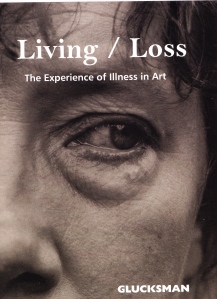 The Lewis Glucksman Gallery, University College Cork (in association with the Alimentary Pharmabiotic Centre, UCC) showcased an exhibition entitled Living/Loss: The Experience of Illness in Art, which presented a variety of artworks related to illness, healthcare and medical treatment. The exhibition was displayed between November 23, 2012 – March 10, 2013.
The Lewis Glucksman Gallery, University College Cork (in association with the Alimentary Pharmabiotic Centre, UCC) showcased an exhibition entitled Living/Loss: The Experience of Illness in Art, which presented a variety of artworks related to illness, healthcare and medical treatment. The exhibition was displayed between November 23, 2012 – March 10, 2013.
Artists participating in the exhibition were as follows: Cecily Brennan, Martin Creed, Damien Hirst, Laura Potter, Mary Rose O’Neill, The Project Twins, Paul Seawright, Jo Spence, and Thomas Struth
In the catalogue accompanying the exhibition Professor Fergus Shanahan writes:
But life is not fair, illness is not dispensed in even measure or degree, nor is it visited on those best equipped to cope with it. How can we understand what it fells like to be ill? Whereas, the signs of disease are often similiar in different individuals, the experience of disease – the illness – is unique to each sufferer. Science gives us a way of thinking about disease, but the arts and humanities provide insight, context and understanding of what if means to be ill.
Living/Loss displayed the human experience of diagnosis, waiting rooms and treatment. To be interpreted within a healthcare system brings attention to symptoms, conditions and ailments. However, the personal stories of illness are complex, fraught with loss, fear and anxiety. The embodied affects of illness are intertwined with personal narratives and relationships to the underside of our bodies, largely a mystery to us. Medical care brings to light a fuller picture of our body, beyond what we are conscious of during the course of everyday life.
Fergus Shanahan writes,
Perhaps the most regrettable and avoidable aspect of illness is the stigma associated with some conditions and the shame that patients may feel. In this context, the loss of dignity compounds the overall sense of loss. Words can perpetuate the stigma when they unnecessarily define a person by his/her disease…Even with life’s most stigmatised illnesses, art can empower the sufferer, uphold dignity, provide a voice, and make a defiant statement. Art expresses the emotions of illness when words fail.
Particular artists offered striking testimonies to the endurance of the human spirit through adversity. Jo Spence’s photo documentary of her body undergoing breast cancer treatment is evocative and emotionally powerful. The essay written by Mary Rose O’Neill exploring the unsettling effects of sorrow, accurately reflects the disorientation one feels within bereavement. Performance artist Bobby Baker has published illustrations depicting her experiences of medical treatment after being diagnosed with borderline personality disorder and breast cancer. Her forthright accounts of treatment within the National Health Service, advocates for a better understanding between medical practitioners and service users.
Vancouver’s Healthy Ageing through the Arts Project
January 25, 2013
The Vancouver Parks Board believes that the arts are an integral part of everyday life. Parks are a reflection of the cultural vitality of the community. Places where people are able to learn, and express creativity in ways that build healthy communities.
Vancouver’s Healthy Ageing Throuth the Arts Project, was inspired by a US report entitled The Creativity and Aging Study (2006) by Dr. Gene Cohen (George Washington University, Washington, D.C.). This study concluded that the arts had positive results for older people by reducing doctor’s visits and dependency on medication, while increasing a sense of well being through participation in cultural activities. The Cohen study also suggested that participation in the arts was a key ingredient in health promotion and prolonged independent living.
Inspired by the Cohen report, The Vancouver Board of Parks and Recreation initiated a three year pilot project, which developed a series of artist-led workshops for older people. Jil Weaving, Co-ordinator of Arts and Culture for the Vancouver Board of Parks and Recreation, believes that through their own arts and health project they have discovered a link between participation in the arts and an increased sense of well being amongst older people. Participants reported a reduction in chronic pain, and an increased sense of being truly involved within their communities. Fundamentally, says Weaving, the healthy ageing project explores what makes life meaningful, by making visible seniors’ contribution to their communities, based on their own identification of important life themes and events.
According to the Vancouver Parks Board website, artists worked with older people in a variety of disciplines ranging from the visual arts, the written word, multi-disciplinary performance and digital storytelling. The participants were collaborators with the facilitating artists, and developed exhibitions and performances as a result of their programme of activities. The participants also attended cultural events within Vancouver as part of the learning agenda. Overall, the project “redefined and enhanced the role of seniors in their community”. Their lives were visible, a positive influence to others, and an integral part of the cultural tapestry within the city.
A full report evaluating the positive outcomes of the Healthy Ageing Through the Arts Project can be downloaded from the Vancouver Parks Board website, by searching under Arts and Health or the title of the report The Arts, Health and Seniors Project: A Three Year Exploration of the Relationship Between Arts and Health by Alison Phinney, Elaine Moody, Mark Pickersgill, Juan Gabriel Solorzano, Margaret Naylor and Jil P. Weaving.
Arts Care Northern Ireland recently celebrated its twenty-first year, and is a exemplary model for the role of artists in healthcare. It’s ethos is ‘ to enable people in health and social care to transform their lives through participation in creative activities”
Arts Care NI employs twenty artists in residence who work as creative practitioners in dance, film, visual art, music, drama, creative writing and craft.
The Southern Health and Social Care Trust collaborates with Arts Care and artist in residence Gwen Stevenson to produce a variety of innovative projects documenting the memories, life stories and challenges of local service users. “The service users and staff from the Newry and Mourne area have expressed how much they have benefitted from participating in the Arts Care arts programme throughout the year. Reported benefits such as decreased isolation, enhanced mental health, reduced stress and increased levels of well-being all demonstrate how the arts can transform staff and service users experience of health and social care” (Dr. Jenny Elliot, Chief Executive Officer, Arts Care).
Examples of recent projects include Looking for a Better Day a short film profiling the stories of senior citizens in Crossmaglen, South Armagh. The film documents experiences of rural isolation, emigration and unemployment, and acts as a social history tool for primary school students. The collective stories of Crossmaglen elders was uploaded on to You Tube so that family members and friends across the globe could hear these ‘stories of resilience, acceptance and sheer hard work’ (Arts Care, Annual Reprt 2011-2012).
Another project ‘I’ for Individual produced a DVD which showcased the results of a Digital Storytelling workshop. where participants were asked to collect the memorabilia of their lives as the starting point to sharing their life story. Each participant also created a soundtrack to accompany their story.
An animation film called Lose the Mask was developed in conjunction with Children and Adolescent Mental Health Services, to offer teenagers information about their first appointment with the mental health team. Mental health professionals worked with teenagers attending their services to create the film which includes art, acting and music devised by the teenagers themselves. The film in intended for the website of Children and Adolescent Mental Health Services.
Southern Health and Social Care Trust Newry and Mourne Chairperson: Marian Cully 048-3083 4322
For more information on Arts Care Northern Ireland contact 048-9053 5639
Pictures at an Exhibition: Arts Meet the Science of Alzheimers
December 6, 2012
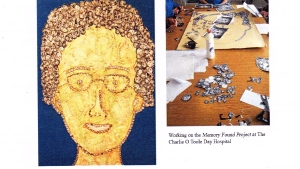 Pictures at an Exhibition: Arts Meet the Science of Alzheimers was a seminar organised by the National Centre of Arts and Health, which showcased a number of projects pertaining to how the arts could examine the experiences of dementia. The seminar was supported by The Meath Foundation, The Arts Council, Dublin City of Science 2012 and The Centre for Ageing, Neuroscience, and the Humanities at the Adelaide and Meath Hospital (Tallaght). It was an innovative exploration of how dementia could be investigated through both medical imagery and the arts.
Pictures at an Exhibition: Arts Meet the Science of Alzheimers was a seminar organised by the National Centre of Arts and Health, which showcased a number of projects pertaining to how the arts could examine the experiences of dementia. The seminar was supported by The Meath Foundation, The Arts Council, Dublin City of Science 2012 and The Centre for Ageing, Neuroscience, and the Humanities at the Adelaide and Meath Hospital (Tallaght). It was an innovative exploration of how dementia could be investigated through both medical imagery and the arts.
The seminar featured a composition by Ian Wilson performed by the Irish Chamber Orchestra. Ian and the Irish Chamber Orchestra were in residence at the Age Related Health Care Unit at Tallaght Hospital for three months. Visual artist Lucia Barnes also presented the visual outcome of her residency, through a display of paintings and collages made by people with dementia and family carers.
Textile artist Carrie Kinahan also presented photos of her NCAD graduation show, which featured a visual depiction of dementia through textile arts. Her artwork, developed as an outcome of visiting a woman living with dementia, is a journal which maps the landscape of dementia. Carrie seeks to showcase how “narratives are organically created in textiles to lead the viewer through a visual experience at a emotional level” (Kinahan, 2012).
The seminar achieved its aim of documenting the interplay between neuro imaging and images of personhood, as revealed through the many stages of dementia. The potential of the visual arts and music to stimulate expressions of subjectivity within the context of dementia, are noteworthy. The significance of ‘memory’, ‘loss’, and ‘identity’ as connections to meaningful experience, links dementia to the realities of the human condition. The seminar highlighted the meaning of dementia for us as a human collective, not only as a audience.
The pictures shown above were produced with visual artist Lucia Barnes, during her residency with the National Centre for Arts and Health and the Age Related Health Care Unit, Adelaide and Meath Hospital, Tallaght. The pictures are called Self Portrait and Interior Mapping.
Waterford Healing Arts Trust
November 20, 2012
The Waterford Healing Arts Trust (WHAT) offers a vital source of information for arts and health practitioners. It is a centre for best practice within arts and health and acts as an essential example of professional practice.
WHAT is based in Waterford Regional Hospital, located in a purpose built centre for the arts, which includes an arts and health library. The centre is a national resource for the professional development of arts and health, and regularly participates in national seminars and conferences dedicated to developing the field of arts and health services. The website http://www.waterfordhealingarts.com offers resources such as Participatory Arts Practice in Healthcare Contexts – Guidelines for Good Practice.
In collaboration with CREATE (National Development Agency for Collaborative Arts), WHAT has developed the Arts and Health website http://www.artsandhealth.ie which showcases case studies, dialogue, news items, and research of interest to arts and health practiioners.
Besides offering professional development opportunities for arts and health practitioners, WHAT aims to enhance the built and social environment of Waterford Regional Hospital, by displaying an extensive collection of art works, by employing artists in residence, by facilitating arts workshops and cultural excursions for staff, and by offering healthcare users a chance to express their experiences through the arts. WHAT also offers community outreach services, through their open studios, connections with youth and older peoples’ services, and music workshops offered through the services of the Brothers of Charity.
According to the Arts Council and WHAT, arts and health activities have many benefits:
For the healthcare setting art helps to reduce environmental stress, offering a more positive experience for service users, staff and visitors. For the service user artworks enhance their relationships with staff, offering a place to communicate their identity and life stories. The arts increase well-being and self confidence which can aid recovery, and certainly enhance the stimulation of waiting rooms, hallways, wards, and treatment areas. For healthcare staff the arts improve their working environment, and enhance their understanding of the individuality of healthcare users. Staff members may develop their own creative talents through staff arts workshops, and through cultural trips to concerts, exhibitions, and theatre performances.
According to research supported by Chelsea and Westminster Hospital Arts on the effects of visual and performing arts in healthcare Dr. Rosalia Lelchuk Staricoff, Jane P. Duncan and Melissa Wright have found that the arts reduce drug consumption, shorten the length of stay in hospitals, and enhance the quality of healthcare services (Reference: ArtsandHealth.ie/Resources/Research).
WHAT’s vital contribution to the arts in Ireland, offers not only an environment of well being within Waterford Regional Hospital, but ignites the potential of healthcare to be an artform within its own right.
Reignite The Spark: Dun Laoghaire-Rathdown County Council and HSE Health Promotion, Dublin South East
November 8, 2012
Reignite the Spark is the title of a report documenting an Arts and Health Partnership between Dun-Laoghaire-Rathdown County Council and the HSE Health Promotion Service Dublin South East/Wicklow. The objectives of the Arts and Health Partnership 2007-2011 was to ensure active participation in the cultural life of the community by those in residential care. It also sought to demonstrate that the arts enriched mental and physical health, and enhanced social activity.
Four residential care facilities were participants in The Arts and Health Partnership:
Dalkey Community Unit and Day Care Services for Older Persons
Coisceim Residential Care Unit
St. Joseph’s House for Deaf and Blind Adults
St. Joseph’s Centre, Day Care and Outreach Services for Older Persons with Age Related Illness
The partnership incorporated a variety of creative practices, i.e. reminiscence, drama, dance, quilting, clay sculpting with storytelling, and singing. Intergenerational school workshops involving drama, links with the Festival of World Cultures, public art launches, and visits to art exhibitions were all part of the activities of the Arts and Health Programme.
The Tea Dance was one of the many interesting case studies of the report, integrating the musical choices of participants, their memories of dances, and describing how both movement and song can become vital links between past and present.
Another intriguing reflection in the report was the way in which hands remembered quilting stitches of the past. As with songs, memories became alive in relation to the creative activities of the present. Life stories were stitched, sculpted, enacted and danced through into the present day, not only enlivening the past, but enriching the present day with important life experiences.
The report was a testimony to how a variety of artistic mediums, special events, and creative practitioners could combine into a vital force for the achievement of well being and expressive realisation.
Photo: An Cathaoirleach Cllr. John Bailey and Geraldine Plunkett, Bealtaine Festival Ambassador at the launch of the report.
Working on the Edge: Exploring the Role of an Art Therapist to that of an Artist in an Arts and Health Context – Similarities, Differences, Requirements is the title of an 2011 article published within the Journal of the Association of Creative Arts Therapists by John McHarg (Art Therapist), Marie Brett (Visual Artist) and Ed Kuczaj (Art Therapist and Head of the Department of Art Therapy and Continuing Visual Education at Crawford College of Art and Design, Cork).
This article addresses the distinction between the work of an art therapist and a visual artist within healthcare. John and Marie worked together over the course of twelve months on an arts and health project at St. Raphael’s Centre for Intellectual Disability, Youghal, Co. Cork. The collaboration between John and Marie culminated in an exhibition entitled On the Edge of My Sky held at the Sirius Arts Centre Gallery, Cobh. This exhibition’s aim was to display artworks without ‘special needs’ tags. The exhibition showcased artworks made by project participants as artworks of merit. The culmination of art research, reflective practice and critical responsiveness amongst the art group at St. Raphael’s Centre, resulted in an exhibition of large scale drawings and paintings. John and Marie also exhibited their own video, sound, and mixed media installations at the Wandesford Quay Gallery, Cork as a counterpoint to the St. Raphael exhibition.
A useful aspect of this article are John’s and Marie’s descriptions of the different roles of the art therapist and artist. One of these differences is the role of supervision for art therapists, an essential requirement of practice. This opportunity for professional reflection and feedback is not always available to visual artists working in healthcare settings. Another difference between the two professions is the importance of art education, criticism, and the quality of art materials available to the visual artist. Aesthetic characteristics and the significance of exhibiting artworks are important considerations for artists in healthcare. In contrast, the art therapist’s role is to establish conditions for artistic expression, attending to the integrity of the therapeutic environment as a confidential space. Public exhibitions are not a usual outcome of art therapy.
The collaboration between an art therapist and artist, extends the territories of artistic practice within healthcare. Features of both professions can enhance a healthcare environment through a dynamic charge of ideas and possibilities of practice.
“Having established a safe working space, we were able to interrogate our practices; their juxtaposition, intersections, similarities and differences, which in turn led to us compiling a body of research and findings which were shared through lectures and round-table discussions” (Marie Brett)
“The intent and purpose of each of the two disciplines were seen to be of the most importance. It defined the method and approach to work of the artist and the art therapist and the expected outcomes of this work. Each discipline approach gained clarity from how the other works” (John McHarg).
